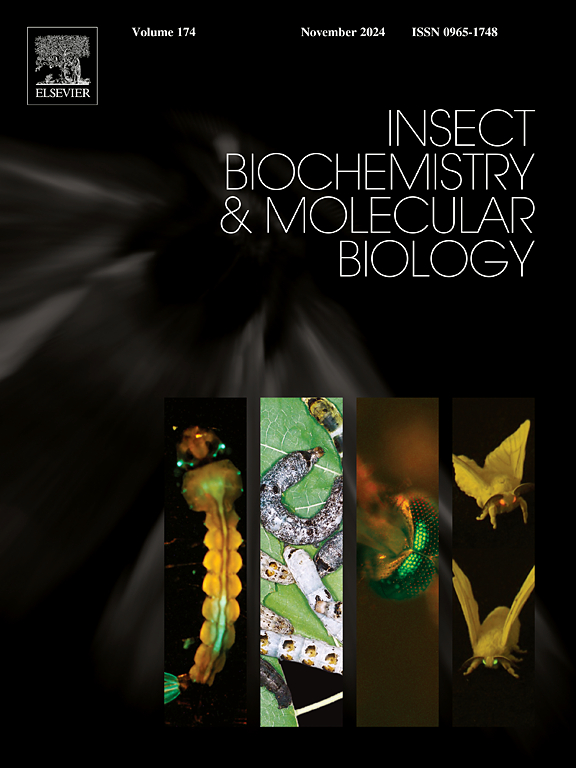Role of histone methylation in insect development: KMT5A regulates ecdysteroid biosynthesis during metamorphosis of Tribolium castaneum
IF 3.7
2区 农林科学
Q2 BIOCHEMISTRY & MOLECULAR BIOLOGY
引用次数: 0
Abstract
Methylation levels of core histones play important roles in the regulation of gene expression and impact animal development. However, the methyltransferases and demethylases that determine histone methylation levels remain largely unexplored in insects. Most of our current understanding of histone methylation comes from mammalian studies. In this study, we first identified potential histone methyltransferases and demethylases encoded in the genome of the red flour beetle Tribolium castaneum. The function of these histone methylation enzymes in the metamorphosis was investigated by knocking down genes coding for these enzymes using RNA interference (RNAi). Our results showed that a lysine methyltransferase, KMT5A, plays a critical role in T. castaneum metamorphosis by regulating the biosynthesis of ecdysteroids. Treating KMT5A-knockdown larvae with 20 hydroxyecdysone can partially rescue T. castaneum pupation. Western blot analysis showed that KMT5A catalyzes H4K20 mono-methylation. However, further studies suggest that KMT5A may regulate T. castaneum pupation through mechanisms independent of H4K20 methylation. These data uncovered the roles of histone methylation enzymes in T. castaneum metamorphosis and KMT5A as a critical regulator of ecdysteroid biosynthesis.

组蛋白甲基化在昆虫发育中的作用:KMT5A调节三角虫变态过程中表皮类固醇的生物合成
核心组蛋白的甲基化水平在基因表达调控和动物发育中发挥重要作用。然而,在昆虫中,决定组蛋白甲基化水平的甲基转移酶和去甲基化酶在很大程度上仍未被探索。我们目前对组蛋白甲基化的大部分理解来自哺乳动物研究。在这项研究中,我们首次鉴定了红粉甲虫Tribolium castaneum基因组中编码的潜在组蛋白甲基转移酶和去甲基化酶。通过RNA干扰(RNAi)敲除这些酶的编码基因,研究了这些组蛋白甲基化酶在变态中的功能。我们的研究结果表明,赖氨酸甲基转移酶KMT5A通过调节外皮甾体的生物合成在甘蔗变态过程中起关键作用。用20羟蜕皮素处理kmt5a基因敲低的幼虫,可部分挽救木棉螟化蛹。Western blot分析显示KMT5A能够催化H4K20的单甲基化。然而,进一步的研究表明,KMT5A可能通过独立于H4K20甲基化的机制调节木浆虫的化蛹。这些数据揭示了组蛋白甲基化酶在castaneum变态中的作用,以及KMT5A作为表皮甾体生物合成的关键调节因子。
本文章由计算机程序翻译,如有差异,请以英文原文为准。
求助全文
约1分钟内获得全文
求助全文
来源期刊
CiteScore
7.40
自引率
5.30%
发文量
105
审稿时长
40 days
期刊介绍:
This international journal publishes original contributions and mini-reviews in the fields of insect biochemistry and insect molecular biology. Main areas of interest are neurochemistry, hormone and pheromone biochemistry, enzymes and metabolism, hormone action and gene regulation, gene characterization and structure, pharmacology, immunology and cell and tissue culture. Papers on the biochemistry and molecular biology of other groups of arthropods are published if of general interest to the readership. Technique papers will be considered for publication if they significantly advance the field of insect biochemistry and molecular biology in the opinion of the Editors and Editorial Board.

 求助内容:
求助内容: 应助结果提醒方式:
应助结果提醒方式:


